| Pages:
1
2 |
Fluorite
Hazard to Others
  
Posts: 138
Registered: 26-12-2018
Location: United Arab Emirates
Member Is Offline
|
|
What about Phosgene?
|
|
|
njl
National Hazard
   
Posts: 609
Registered: 26-11-2019
Location: under the sycamore tree
Member Is Offline
Mood: ambivalent
|
|
What about it...
|
|
|
teodor
National Hazard
   
Posts: 876
Registered: 28-6-2019
Location: Heerenveen
Member Is Offline
|
|
White fuming nitric acid ?
I post it here just because we discussed it here, also B(a)P pointed me to NurdRage video which I studied well and then tried to get RFNA by mixing
equal volume of an azeotropic acid and H2SO4 and distilling it with a fractionating column.
What is weird is that it seams I've got WFNA instead of RFNA and I didn't use any vacuum for that.
I've attached here some photos of my process and results.
What could be relevant: I use acid distilled from AgNO3, so it doesn't contain halogens. And I use pure concentrated H2SO4, not a cleaner. Also during
the mix of acids ice-cooling was used, so the mixture was kept cold all the time so it didn't generate nitric oxides on the mixing stage.
So, this general view of my setup:
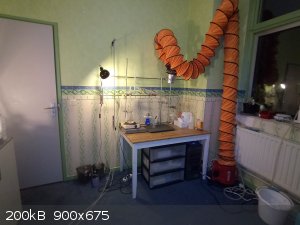
I noticed that there are 2 peaks of decomposition - when the mixture starts and stops boiling. Decomposition is always in some point before
condensation, so it always happens in vapour phase only.
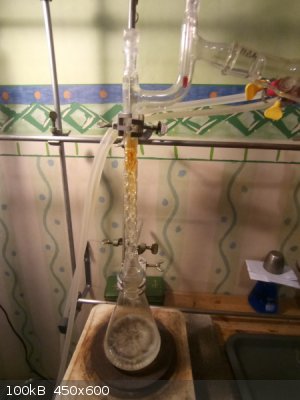
This is color of the acid. It distils at the temp. 80-81C. I suspect the dissolved oxides cause this boiling temperature depression (it should be 83C
otherwise).
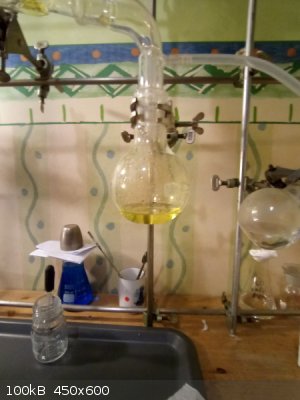
During the constant boiling the decomposition (brown oxides) are visible only in the beginning of the condenser. But it decomposes not much, look the
color.
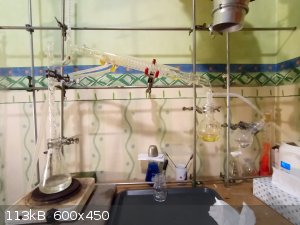
When most of acid was distilled the temperature of vapours becomes 79.5C (more oxides?) and at this point second active decomposition started. But
most of it appeared after switching-off my hot plate. So, at this stage distillation already stopped and fumes are mostly in the source flask.
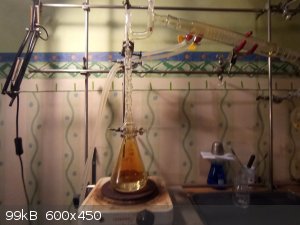
Probably you can see white fumes here. They are really dense but photo is not perfect. I have a video of the process where the white fumes are visible
much better. Probably will share it on my youtube channel later.
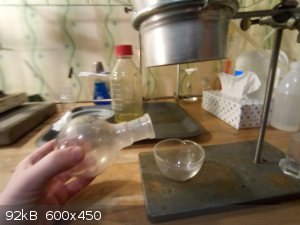
Edit: I analysed the photos and I noticed that the decomposition is ALWAYS during condensation of vapours. So, my hypothesis is that only parameters
of condensation during the process (speed?) contribute to the oxides percentage in the final product.
Edit 2: Another explanation of forming NO2 in the point of _final_ condensation is that it needs O2 to form NO2, so the decomposition reaction goes
not like that: 4HNO3 = 2H2O + 4NO2 + O2 . In this case it should consume O2 to form NO2 because there is no brown NO2 in the points before
condensation.
[Edited on 7-12-2020 by teodor]
|
|
|
Fluorite
Hazard to Others
  
Posts: 138
Registered: 26-12-2018
Location: United Arab Emirates
Member Is Offline
|
|
Anyone tried this method? I distilled DCM using my diy pvc distillation setup I know I can't use it for nitric acid obv that's why I wanna try this
And can I use sodium bisulfate + calcium nitrate instead? Should I add catalytic amounts of water?
|
|
|
Sulaiman
International Hazard
    
Posts: 3696
Registered: 8-2-2015
Location: 3rd rock from the sun
Member Is Offline
|
|
Quote: Originally posted by teodor  | ... I noticed that there are 2 peaks of decomposition - when the mixture starts and stops boiling. Decomposition is always in some point before
condensation, so it always happens in vapour phase only.
|
It could be that the NO2 is just more visible as the density of the gas increases as it is cooled.
CAUTION : Hobby Chemist, not Professional or even Amateur
|
|
|
teodor
National Hazard
   
Posts: 876
Registered: 28-6-2019
Location: Heerenveen
Member Is Offline
|
|
Quote: Originally posted by Sulaiman  | Quote: Originally posted by teodor  | ... I noticed that there are 2 peaks of decomposition - when the mixture starts and stops boiling. Decomposition is always in some point before
condensation, so it always happens in vapour phase only.
|
It could be that the NO2 is just more visible as the density of the gas increases as it is cooled. |
If so I would expect it visible in the condenser during the distillation.
|
|
|
| Pages:
1
2 |